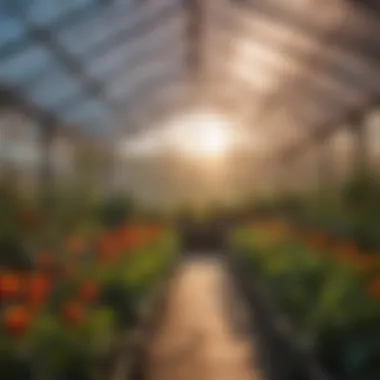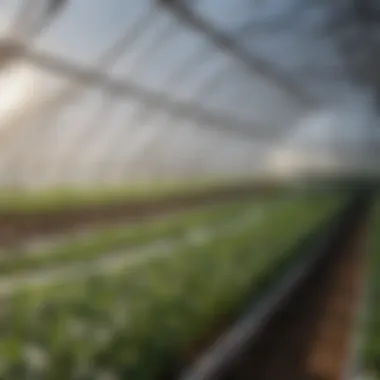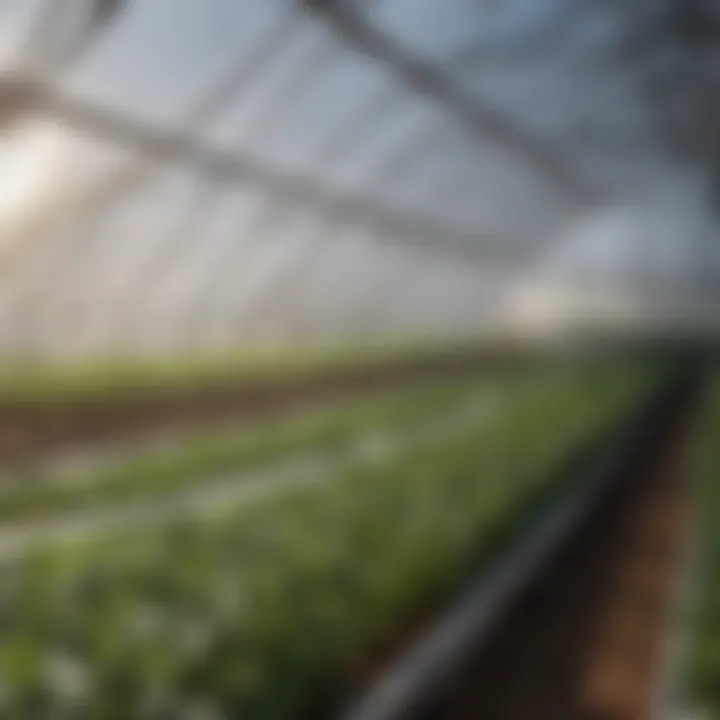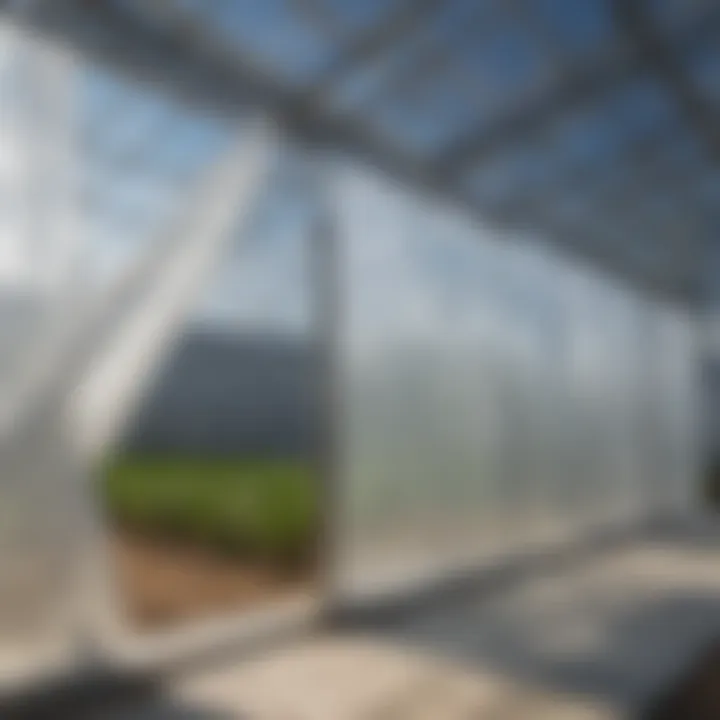Exploring Greenhouse Plastic Sheeting: A Comprehensive Guide


Intro
In agriculture, the choice of materials significantly impacts productivity and sustainability. Among these, greenhouse plastic sheeting plays a pivotal role. It serves as a protective barrier, fostering an optimal environment for plant growth. This introduction outlines the fundamental elements involved in greenhouse plastic sheeting, emphasizing its relevance to modern agricultural practices.
Topic Overview
Definition and Importance
Greenhouse plastic sheeting is a form of covering material used in agricultural structures, specifically greenhouses. Its primary function is to regulate temperature and control humidity, creating a conducive environment for various crops. This sheeting enhances photosynthesis by allowing sunlight to penetrate while also shielding plants from adverse weather conditions. The importance of greenhouse plastic sheeting cannot be overstated; it significantly contributes to increased crop yields and extended growing seasons.
Brief History and Evolution
The evolution of greenhouse plastic sheeting dates back to the early 20th century, when glass was commonly used. This material had several downsides, including high weight and cost. The advent of plastic in the 1960s revolutionized greenhouse design due to its lightweight, durability, and cost-effectiveness. Over the decades, innovations in polymer technology have led to the development of different types of plastics, each designed to meet specific agricultural needs. Today, options like polyethylene, polycarbonate, and acrylic sheeting are widely used, each providing unique benefits.
"The transition from glass to plastic marked a significant turning point in agricultural practices, allowing for increased accessibility to greenhouse technology."
Key Techniques and Innovations
Sustainable Farming Practices
The integration of sustainable practices in agriculture has grown in importance. Greenhouse plastic sheeting contributes to these efforts by enabling more water-efficient and energy-efficient farming. Use of recycled materials for sheeting and solar heating systems is on the rise. These innovations lead to reduced environmental impact, aligning with global sustainability goals.
Advanced Agronomic Technologies
Current trends also include the use of smart technologies in greenhouse management. Sensors monitor humidity, temperature, and light levels, ensuring optimal conditions for plant growth. These technologies, when paired with high-quality plastic sheeting, can dramatically increase efficiency and output.
Practical Applications
Step-by-Step Guides
- Choosing the Right Sheeting: Consider factors like UV resistance, thermal properties, and durability.
- Installation: Ensure proper tensioning and sealing to prevent air leaks and maintain structural integrity.
- Maintenance: Regularly check for wear and tear, cleaning the surface to allow maximum light transmission.
Case Studies or Real-World Examples
Numerous successful cases exist illustrating the effective use of greenhouse plastic sheeting. For instance, farmers in California have reported increased yields after switching from glass to polyethylene sheeting. This transition allowed them to better control environmental variables, leading to healthier crops and higher profitability.
By understanding greenhouse plastic sheeting's significance, farmers can make informed decisions that enhance productivity and sustainability in their agricultural practices.
The Importance of Greenhouse Plastic Sheeting
Greenhouse plastic sheeting is a critical component in modern agriculture. It serves multiple purposes that enhance the effectiveness and efficiency of farming practices. This section highlights several key elements regarding its importance, including its role in sustainable agriculture, impact on crop yield, and benefits in temperature regulation.
Role in Sustainable Agriculture
Greenhouse plastic sheeting contributes significantly to sustainable agricultural practices. It helps protect crops from harsh environmental factors, such as extreme weather conditions and pests. By creating a controlled growing environment, farmers can minimize the use of pesticides and fertilizers. This leads to more organic cultivation methods, reducing the ecological footprint of farming activities.
Moreover, greenhouses extend the growing season, allowing the cultivation of crops in regions with less favorable climates. This helps in maximizing the use of land resources, which is vital as global population growth increases the demand for food production. The use of greenhouse plastic sheeting aligns with sustainable practices by conserving water, enhancing crop resilience, and reducing the need for chemical inputs.
Impact on Crop Yield
The effectiveness of greenhouse plastic sheeting directly correlates with crop yield improvement. By providing an optimal growing environment, the sheeting allows for better growth and health of plants. Essential factors like light penetration, humidity control, and protection from pests and diseases can be finely tuned. As a result, plants grow faster and yield higher quantities of produce.
In many cases, farmers report significant increases in yield after switching to greenhouse methods enhanced with quality plastic sheeting. It allows for more intensive cultivation and often results in produce that is not only larger but also of superior quality. This increase in yield can be critical for farmers looking to improve their livelihoods and sustain their operations over time.
Temperature Regulation Benefits
One of the primary functions of greenhouse plastic sheeting is temperature regulation. Greenhouses create a microclimate that can be managed more effectively than outdoor conditions. The sheeting acts as a barrier, trapping heat during colder weather while reflecting sunlight to prevent overheating when temperatures rise. This balance is essential for optimizing plant growth and development.
The unique properties of greenhouse plastics allow for significant thermal insulation. This feature helps in maintaining a consistent climate, which is pivotal for sensitive crops. For instance, tomatoes and peppers thrive in specific temperature ranges, and the ability to control this aspect through strategic use of plastic sheeting leads to better growth outcomes.
"Greenhouse plastic sheeting is pivotal for balancing natural systems with agricultural needs, crucial for today’s high-demand food production landscape."
Types of Greenhouse Plastic Sheeting
Understanding the various types of greenhouse plastic sheeting is crucial for anyone in agriculture or horticulture. Each type of material has its benefits and drawbacks, which can significantly impact the growing environment for plants. Proper choice of sheeting affects temperature, light transmission, and overall plant health. Additionally, the economic factors associated with different materials can influence a farmer's operational costs. Therefore, knowing the available options helps in making informed decisions that align with specific agricultural goals.
Polyethylene Sheeting
Polyethylene sheeting is the most common type used in greenhouses, primarily due to its cost-effectiveness and versatility. It comes in several thicknesses, providing choices based on different climatic conditions. Notably, it offers excellent light transmission, enabling optimal photosynthesis for plant growth.


Benefits include:
- UV Resistance: Enhanced UV protection prolongs the life of the material.
- Economical: Generally less expensive than other options.
- Flexible Installation: Can be installed easily on various greenhouse structures.
Despite its advantages, polyethylene sheeting has a limited lifespan, usually around four to six years. Regular maintenance and timely replacement are necessary to ensure a productive growing environment.
Polycarbonate Panels
Another option for greenhouse sheeting is polycarbonate panels. These are recognized for their durability and insulation properties. Unlike polyethylene, polycarbonate can withstand harsh weather conditions, including hail and strong winds.
Key features are:
- Insulating Properties: They retain heat better than polyethylene, essential in colder climates.
- Long Lifespan: Can last over ten years with proper care, making them a good long-term investment.
- Safety: Less likely to break compared to glass, thus reducing injury risks.
However, polycarbonate panels come at a higher price point. Their initial investment can be significant, but many find the durability and thermal efficiency worth it in the long run.
PVC Sheeting
PVC sheeting is less common than the previous types but still holds a place in specific greenhouse applications. It is known for its strong resistance to chemicals and mold, making it ideal for specialized growing scenarios.
Strengths include:
- Mold Resistance: PVC does not support mold growth as much as other materials.
- Lightweight: Easier to handle during installation.
- Variety in Thickness: Available in many thicknesses, allowing for tailored applications.
On the downside, PVC sheeting does not provide the same level of UV stability as polyethylene, which may lead to quicker degradation over time, typically around five years of effective use.
Other Materials to Consider
Besides the common types already mentioned, several other materials can serve as greenhouse sheeting, such as acrylic and greenhouse films with additives.
Consider these options:
- Acrylic Sheets: Known for outstanding light transmission and impact resistance, albeit at a higher cost.
- High-Performance Films: Some films are designed with advanced UV blockers and thermal properties for enhanced plant growth years.
When exploring other materials, it is essential to assess cost, light diffusion, and environmental compatibility. Each material serves unique growing conditions and can contribute to the greenhouse's sustainability.
Understanding the types of greenhouse plastic sheeting available allows farmers to choose the best option for their specific needs. This choice is essential for optimizing plant growth, maximizing yield, and ensuring long-term sustainability.
Choosing the Right Greenhouse Sheeting
The selection of greenhouse sheeting is a critical decision that directly impacts the efficiency and sustainability of agricultural practices. The right sheeting can significantly enhance crop productivity, create a controlled environment for plants, and reduce energy costs associated with heating and cooling. Furthermore, understanding the variables involved in this choice ensures that both novice and experienced growers can optimize their greenhouse operations. Factors such as climate, UV resistance, and durability all play a vital role in making an informed decision about greenhouse sheeting.
Assessing Your Climate
Climate conditions vary dramatically around the world. This variation influences not just the growth of crops but also the effectiveness of greenhouse sheeting. For instance, if you are located in a region with high temperatures, lighter sheeting can help reflect sunlight, reducing excess heat. Conversely, in cooler climates, thicker, insulating materials may be necessary to retain warmth. Local weather patterns, including humidity and wind exposure, should also be taken into consideration.
- Temperature Variability: Choosing sheeting that can adapt to swings in temperature is essential for maintaining optimal conditions for plant growth.
- Local Precipitation Levels: If rain is abundant, select materials designed to withstand moisture without sagging or degrading.
Knowing your climate enables you to enhance both the performance of the sheeting and the results of your crops.
Understanding UV Resistance
Ultraviolet (UV) radiation is a critical element to consider when selecting greenhouse plastic. Not all sheeting offers the same level of UV protection, which means some materials can degrade faster than others. UV-resistant sheeting extends the lifespan of the plastic while minimizing the risk of plant damage from excessive sunlight exposure.
Key points to consider include:
- Material Composition: Polycarbonate panels, for example, tend to have better UV resistance over time compared to standard polyethylene sheeting.
- Integration of UV Stabilizers: Look for sheeting containing UV stabilizers. This feature can enhance longevity and protect crops by filtering harmful rays.
Understanding UV resistance can therefore provide your plants the necessary protection to thrive.
Durability and Longevity Considerations
Durability is another paramount aspect of selecting greenhouse sheeting. The investment in greenhouse plastic sheeting is not trivial, and choosing materials that withstand environmental stressors can prevent frequent replacements and added costs.
- Thickness of Material: Thicker sheets often exhibit greater durability and can manage physical impacts better than thinner options.
- Quality of Material: Not all products are created equally; reputable brands often offer warranties and better customer support.
- Resistance to Environmental Elements: Consider sheeting that can resist tearing, punctures, and extreme weather conditions, ensuring a longer lifespan and lower maintenance requirements.
In summary, taking time to assess your unique climate, understanding UV resistance capabilities, and examining durability will significantly enhance your decision-making process when choosing greenhouse sheeting. Your choice impacts not just the immediate growing conditions, but also long-term sustainability in your agricultural practices.
Local Sourcing Options for Greenhouse Plastic


Sourcing greenhouse plastic locally can greatly enhance the efficiency and sustainability of your agricultural practices. Local suppliers often have a clearer understanding of the specific needs associated with your regional climate and soil conditions. They may also offer products tailored to the local agricultural community. Sourcing locally can reduce transportation costs and time delays, which positively affects your project timelines. Plus, establishing a relationship with local suppliers can lead to better support and service, including advice on installation and maintenance of plastic sheeting.
Finding Suppliers Near You
When searching for greenhouse plastic suppliers in your vicinity, start by utilizing online resources. Websites such as Google Maps or local business directories can be valuable tools. Search with key terms like "greenhouse plastic suppliers near me" or "agriculture supplies." Additionally, consider checking platforms like Facebook and Reddit, where local farmers may share recommendations or experiences with particular suppliers.
Another approach is to connect with agricultural cooperatives or organizations in your area. They often have established relationships with suppliers and can provide referrals. Local gardening clubs or farmers’ markets may also offer insight into reliable options, as members often share their trusted sources.
Comparative Pricing and Availability
Once you have identified potential suppliers, a careful consideration of pricing and availability is crucial. It is essential to gather quotes from multiple vendors to understand the market rate for the type of greenhouse plastic you need. Compare not only the prices but also the thickness and durability of the sheeting, as these factors can directly influence your costs and long-term performance.
Inquire about bulk purchasing discounts or seasonal pricing strategies as well. Some suppliers may have sales during certain times of the year. By being aware of price fluctuations and availability, you can make a more informed decision that aligns with your budget and project timelines.
Evaluating Supplier Reputation
Before finalizing your choice, it is important to evaluate the reputation of the suppliers you are considering. Look for reviews and testimonials from other customers to gauge their experiences. Websites like Google Reviews or industry-specific forums can offer insight into the reliability and quality of products offered by certain suppliers.
Consider asking for references to get first-hand accounts of service quality. A reputable supplier should be transparent about their products, including specifications and warranties. Establishing a relationship with a trustworthy supplier can ensure you receive quality materials and support, which ultimately contributes to your gardening success.
Remember, investing time in local sourcing can yield benefits over the long haul through better quality products and support.
Installation of Greenhouse Plastic Sheeting
The installation of greenhouse plastic sheeting is a critical aspect of establishing an effective greenhouse environment. This process directly affects the longevity of your sheeting, the insulation qualities, and the overall productivity of your plants. Proper installation not only secures the structure but also optimizes the benefits of greenhouse plastic, such as moisture retention and temperature control. Hence, understanding the steps involved in installation can lead to enhanced crop yields and reduced operational costs.
Preparation and Tools Needed
Before beginning the installation, careful preparation is essential. First, assess the greenhouse structure to ensure there are no damages that could affect the installation. Gather all necessary tools to streamline the process. Here are the commonly needed items:
- Measuring tape
- Utility knife
- Ladder
- Staple gun or tensioning devices
- Optional: Silicone sealant for additional sealing needs
Additionally, inspect the sheeting for any defects. Ensure that the chosen plastic sheeting is appropriate for your greenhouse and the climate in your area.
Step-by-Step Installation Process
- Clean the Structure: Remove any debris or old sheeting from the greenhouse frame. This ensures a clean surface for installation, allowing the new sheeting to adhere correctly.
- Measure: Use a measuring tape to accurately gauge the dimensions of your greenhouse. This will help you cut the plastic sheeting to the required size without excess material that could flap in the wind.
- Cut the Sheeting: With a utility knife, cut the sheeting to match the measured dimensions, leaving some extra for overlapping.
- Fasten the Plastic: Start at one edge of the greenhouse, laying down the sheeting and securing it with a staple gun or other tensioning devices. Make sure it is tight and wrinkle-free, as loose sheeting can lead to heat loss and moisture problems.
- Overlap and Seal: If you have multiple sheets, overlap them properly. Use silicone sealant for additional sealing, especially at the edges. This will prevent any water infiltration and keep your greenhouse environment stable.
- Final Inspection: After installation is complete, inspect all seams and attachments. Ensure that everything is secure and make adjustments as necessary.
Common Installation Mistakes to Avoid
To achieve a successful installation, it is crucial to avoid common pitfalls:
- Ignoring Structure Preparation: Skipping the cleaning process can lead to poor adhesion.
- Inaccurate Measurements: Double-check all measurements to prevent cutting mistakes.
- Uneven Tensioning: Ensure the sheeting is evenly stretched across the structure to prevent sagging.
- Neglecting Sealing: Failing to seal edges properly can cause leaks and reduce the efficiency of the greenhouse.
"A well-installed greenhouse sheeting significantly contributes to optimal growing conditions, reflecting the need for diligence during installation."
By paying attention to these details, your installation of greenhouse plastic sheeting will yield better results, fostering an environment for healthier plants.
Maintenance of Greenhouse Plastic Sheeting
Maintaining greenhouse plastic sheeting encompasses careful monitoring and proactive measures aimed at preserving its integrity and functionality. A well-maintained plastic sheeting can significantly prolong the life of the greenhouse and enhance its ability to support healthy plant growth. Factors such as UV exposure, weather conditions, and physical damage can deteriorate the sheeting over time. Regular maintenance reduces the likelihood of costly replacements and ensures that plants remain sheltered from pests and extreme conditions.
Regular Inspection Protocols
Regular inspection protocols are vital in identifying potential issues with greenhouse plastic sheeting before they escalate. Farmers should establish a routine inspection schedule, ideally checking the sheeting every few weeks. During these inspections, one should look for signs of wear and tear. Common issues include:
- Tears or holes in the sheeting which can allow pests to enter.
- Discoloration that may indicate UV degradation.
- Bubbles or blisters that signal air or moisture accumulation.
Documenting these findings is essential. Keeping a record can help track the progression of any damage and guide decisions regarding repairs or replacements. If significant damage is observed, it may require immediate intervention to prevent further deterioration.
Cleaning and Repair Methods
Cleaning the greenhouse plastic sheeting effectively extends its lifespan. Dirt, algae, and mold can accumulate on the surface, blocking sunlight and impacting plant health. A mixture of mild soap and water can be used to clean the surface. The process involves:
- Diluting soap in water.
- Using a soft cloth or sponge to scrub the sheeting gently.
- Rinsing thoroughly with clean water to avoid soap residue.
For repairs, minor tears can be fixed using clear plastic repair tape. Larger tears might require the use of patches made from similar materials as the original sheeting, ensuring a tight seal. The repaired area should be smooth to prevent any new structural weaknesses.
Seasonal Maintenance Checklist


A seasonal maintenance checklist helps ensure that no critical tasks are overlooked. Here is a suggested list:
- Spring: Inspect for winter damage, clean the sheeting, and repair any signs of wear.
- Summer: Check for UV deterioration, remove excessive heat buildup by conducting ventilation assessments, and ensuring the functioning of cooling systems.
- Fall: Clean thoroughly post-harvest, inspect for possible damages caused by storms, and perform repairs in preparation for winter.
- Winter: Monitor heavy snow or ice accumulation, engage in repairs when the temperatures allow, and prepare for the upcoming growing season.
A proactive approach to maintenance can significantly enhance the lifespan and performance of greenhouse plastic sheeting.
By adhering to proper maintenance protocols, farmers can safeguard their investments and facilitate better growing conditions year-round.
Environmental Considerations of Greenhouse Plastic
The choice of greenhouse plastic sheeting can have significant environmental implications. As awareness regarding sustainability in agriculture increases, understanding these effects becomes crucial for informed decision-making. Greenhouse plastic not only influences crop growth but also impacts local ecosystems. This section focuses on two key aspects: the effects on local ecosystems and guidelines for recycling and disposal.
Impact on Local Ecosystem
Greenhouses have the potential to alter local ecosystems. The materials used, including greenhouse plastic, can influence local wildlife and plant life. When selecting sheeting, factors such as light transmittance and thermal properties can affect the microclimate inside the greenhouse and thus influence the surrounding area. For instance, certain plastics may allow more light, promoting faster plant growth but potentially harming neighboring plant species if not managed properly.
Moreover, the runoff from greenhouses can carry fertilizers and pesticides into nearby waterways. Such impacts can disrupt local aquatic life and biodiversity. Therefore, thoroughly assessing the potential ecological consequences before installing greenhouse plastic will help mitigate negative effects on the environment.
"Sustainable practices are essential for maintaining the health of our ecosystems while still reaping the benefits of greenhouse agriculture."
Recycling and Disposal Guidelines
Disposal of greenhouse plastic is an area that requires thoughtful consideration to minimize environmental impact. Many types of plastic can be recycled, but the procedures may vary widely based on local regulations and available facilities. Here are some guidelines to consider:
- Identify the Plastic Type: Check the recycling number that indicates the type of plastic. Different plastics have different recycling processes.
- Local Recycling Options: Research your local waste management services. Some areas offer specific recycling programs for agricultural plastics.
- Cleaning before Disposal: Rinse off any soil or chemical residues before recycling. Contamination can hinder the recycling process and result in more landfill waste.
- Consider Reuse: Some sheeting materials may be suitable for alternative uses before being discarded, such as ground cover or storage materials.
Economic Factors in Greenhouse Plastic Choices
The economic aspects surrounding greenhouse plastic choices play a crucial role in influencing the overall effectiveness of agricultural practices. For farmers and enthusiasts, understanding these factors can significantly impact both short- and long-term productivity, as well as sustainability. Proper evaluation of economic elements ensures that the choices made concerning plastic sheeting are not only financially sensible but also beneficial for the environment. Various elements come into play when considering the economic implications of greenhouse plastic, including initial investment, long-term savings, and a detailed cost-benefit analysis.
Initial Investment vs. Long-Term Savings
When selecting greenhouse plastic sheeting, the initial cost is often the first consideration. Different materials present varying upfront prices. For example, polyethylene sheeting may provide an affordable solution, but it may not last as long as other options, such as polycarbonate panels.
On the other hand, investing in more durable materials can lead to higher initial expenses. However, they might offer better insulation, require less maintenance, and last several seasons. The decision hinges on analyzing whether the higher upfront costs translate into long-term savings. Here are some key considerations:
- Material Lifespan: Assess how long the material will last before needing replacement.
- Energy Efficiency: Examine if the material helps in maintaining temperature, reducing heating costs.
- Maintenance Costs: Factor in the expenses associated with repairs and upkeep over time.
In summary, while an affordable initial investment in sheeting materials might seem attractive, it often leads to higher long-term expenses if the material proves ineffective or requires frequent replacement.
Cost-Benefit Analysis for Farmers
Conducting a thorough cost-benefit analysis is essential for farmers to determine the feasibility of different greenhouse plastics. This analysis should weigh the potential benefits against the costs involved, offering insights into the most fiscally responsible options available. Here are some critical factors to analyze:
- Yield Potential: Understand how different plastics could boost crop yields by providing better weather protection and temperature control.
- Labor Costs: Enlist how the ease of installation and maintenance may save on labor expenses.
- Market Prices: Consider how improved crop quality due to better sheeting choices could allow for competitive pricing in the market.
- Environmental Impact: Evaluate how sustainable materials may result in lower disposal costs or fewer regulations concerning waste management.
"Understanding the economics behind plastic sheeting choice is as important as the agricultural choice itself."
Ultimately, a careful economic evaluation will enable farmers to make informed decisions. This kind of analysis not only enhances profitability but also contributes to environmentally conscious farming practices.
Emerging Trends in Greenhouse Technologies
The field of greenhouse technology is evolving rapidly. Understanding these emerging trends is vital for farmers and agricultural enthusiasts who aim to optimize their production capabilities and adapt to a changing environment. Each trend brings unique benefits that can enhance crop yields and efficiency while minimizing environmental impact.
Advancements in technology play a role in meeting the demands of modern agriculture. With precision farming gaining traction, these innovations are becoming increasingly relevant to greenhouse operations. They facilitate better resource management and can lead to significant cost savings.
Advancements in Sheeting Materials
In recent years, the development of sheeting materials has focused on improving durability and thermal performance. New composite materials are now available that offer enhanced UV protection, making them last longer under intense sunlight. Manufacturers are also experimenting with coatings that reflect light in specific wavelengths. This reflection can improve plant growth by promoting photosynthesis while reducing heating costs within greenhouses.
Benefits of New Materials
- Increased Lifespan: Modern materials withstand weather extremes better than traditional options.
- Reduced Energy Costs: Effective insulation leads to lower heating bills during colder months.
- Environmentally Friendly Options: Some new materials are recyclable, aligning with sustainability goals.
These advancements indicate a shift towards more resilient and effective greenhouse structures. As farmers incorporate these materials, they report substantial improvements in their operational efficiencies.
Smart Greenhouse Innovations
The concept of smart greenhouses integrates various technologies. Automation and IoT (Internet of Things) devices are transforming how growers manage their crops. These systems can monitor environmental conditions and adjust settings automatically, ensuring optimal growth conditions.
"With smart greenhouse technology, farmers can achieve a level of precision that was once unimaginable."
Key Innovations
- Climate Control Systems: These manage ventilation, heating, and cooling based on real-time data.
- Automated Irrigation: This technology optimizes water usage, ensuring plants receive the right amount at the right time.
- Data Analytics: Analyzing data collected from various sensors can improve decision-making processes.
Smart technologies do not just enhance productivity; they also reduce waste, leading to a more sustainable agricultural model. As these innovations continue to evolve, they will likely become indispensable for those operating greenhouses.



